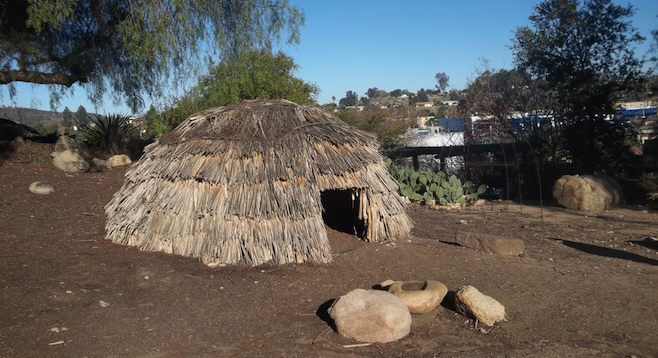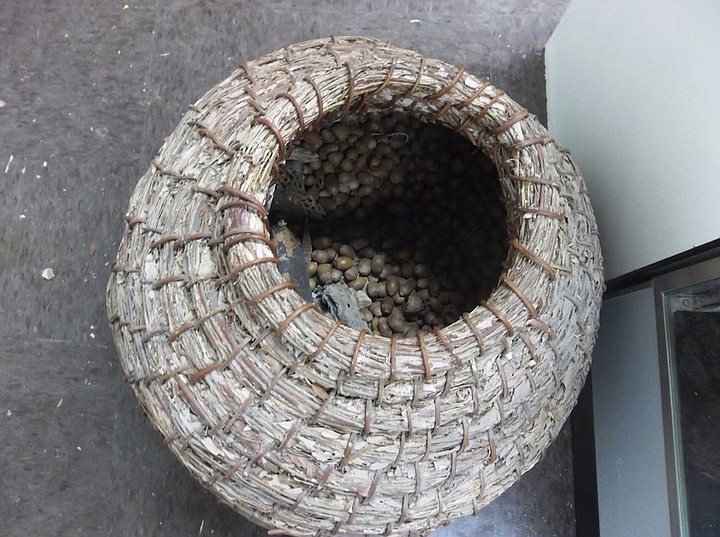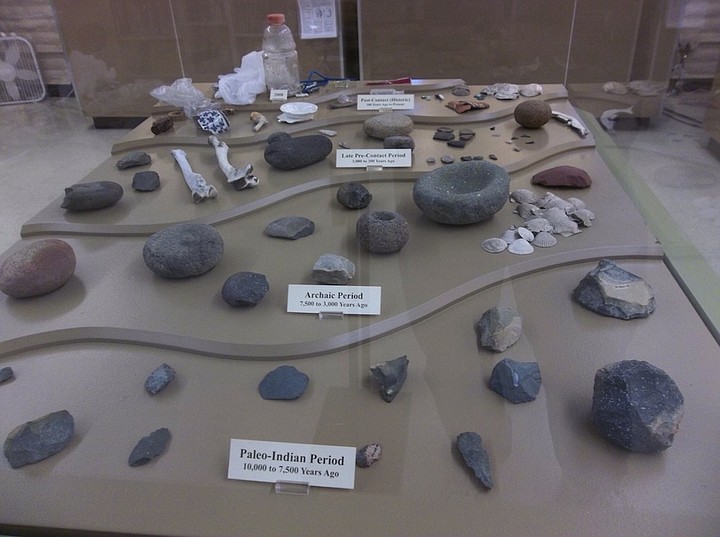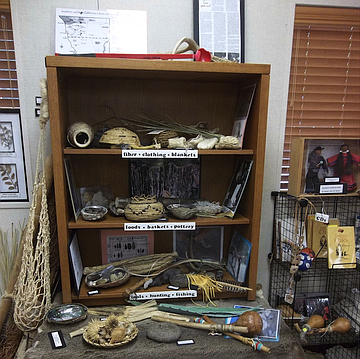 Facebook
Facebook
 X
X
 Instagram
Instagram
 TikTok
TikTok
 Youtube
Youtube

Few people know that San Diego County has more American Indian reservations than any other county in the nation. Native American tribes have lived in the area for over 12,000 years. Today, a majority of the 25,000 Native Americans in the county live off the reservations. But while most people have heard of the Hopi and the Navajo in Arizona, local tribes such as the Kumeyaay (also called Diegueño), Luiseño, Cupeño and Cahuilla are virtually unknown.
I set out to investigate some of the cultural centers and reservations to gain more insight into the cultural heritage that predates the arrival of the Spanish here in San Diego.

Cupa Cultural Center
My first stop was the Pala Reservation. Off the 76 freeway in Pala, just past the plush Pala Casino, the Cupa Center provides information on the Pala Indians and the local Trail of Tears in 1903, in which federal troops forced 200 Indians from the Cupeño tribe in Warner Springs to relocate along the San Luis River in Pala.
There are many photos and artifacts to see here, including baskets and examples of pottery, which provide a glimpse into the lives of the Indians on their native land. In working to preserve their original culture, the Cupa Center offers classes in basket making and other traditional arts and crafts to Pala community members.
Further east along highway 76 there are several other reservations, including the Pauma and La Jolla. The largest reservation in the county is the Los Coyotes reservation off a remote but scenic stretch of the 79. This reservation is one of the most impoverished, as their remote location has prevented them from developing a casino to provide economic relief. They have unsuccessfully pursued an off-reservation casino in Barstow for years, and a proposal is still being litigated. The reservation is on a beautiful stretch of land with a lookout. There's a camping site and several hiking trails available to visitors.
San Diego Archaeology Center

There are over 32,000 archaeological sites in San Diego County. A few miles east of Escondido off 78 in San Pasqual, the San Diego Archaeology Center features a rich collection of artifacts from these sites dating back 9,000 years. The exhibits organize the artifacts by time periods, letting you see the evolution of artifacts over thousands of years. The oldest are 9,000-year-old stone scrapers. Among the most intriguing and mysterious are 5,000-year-old donut stones. Kids can learn the basics of archeology with hand-on activities and games. There are also educational programs for children, and the center welcomes school groups.
On my visit I was invited to attend the upcoming annual reenactment of the 1846 Battle of San Pasqual. Aside from a suggested $2 donation, the center is free to visit.
Barona Cultural Center and Museum
Further south, I headed to the Barona Cultural Center and Museum in the beautiful Barona Valley in Lakeside, just past the huge casino. Take the 67 north, catch the exit and go up Wildcat Canyon Rd. about 13 miles. The brochure describes it as “San Diego’s only museum on an Indian reservation dedicated to the perpetuation and presentation of the local Native American culture.”
I was the only visitor in the museum, and archivist Katy Duperry eagerly answered all my questions and cleared up the distinction between a band and a tribe.
The museum contains over 3,000 artifacts, mostly related to the local Kumeyaay tribe. An exhibit was on display showing Native American athletes. Several artifacts were displayed, including baskets and examples of pottery. Also displayed were remembrances by tribal members of their early years in the area. These heartfelt testimonies can help visitors understand and better relate to the experiences of the native people. Some of the older artifacts can only be seen by appointment with the archivist (Katy). Email her at [email protected].
Kumeyaay-Ipai Interpretive Center

On Saturday mornings from 9-11:30, the Kumeyaay Interpretive Center in Poway offers free tours. It's a worthwhile stop for an education in the traditional lifestyle of the Kumeyaay.
I was welcomed in the center by Mike Horan, the President of the Friends of the Kumeyaay, and viewed quite a collection of artifacts. Docent Helen described their origins, functions and means of construction. These included a skirt made from the bark of a willow tree, musical instruments made from the elderberry tree, baskets used to collect acorns and water, and several examples of pottery. Helen showed me a collection of books that were written and assembled by a local botanist cataloguing the plants used by the Kumeyaay and their functions. She then took me for a walk around the five-acre site to visit the ewaa houses used by the Kumeyaay (top), along with a replica village that provides a sense of their lifestyle. Stepping inside the ewaa gave me a chance to imagine what it might have been like to live in such a dwelling. The center welcomes school groups and provides activities for children including storytelling and painting spirit rocks.
For information about the center, call (858) 668-1292 or visit their website: friendsofthekumeyaay.org.
In visiting these centers, I was struck by the rich cultural histories of the native tribes that are so little known by most San Diegans. I spoke by phone with Rose Davis, editor of Indian Voices newspaper, who's organizing a local American Indian Culture tour. She suggests the value of attending pow-wows to better understand the cultures and added, “There’s always something going on.”
If you'd like more information on the tour, you're welcome to call her at (619) 534-2435.


Few people know that San Diego County has more American Indian reservations than any other county in the nation. Native American tribes have lived in the area for over 12,000 years. Today, a majority of the 25,000 Native Americans in the county live off the reservations. But while most people have heard of the Hopi and the Navajo in Arizona, local tribes such as the Kumeyaay (also called Diegueño), Luiseño, Cupeño and Cahuilla are virtually unknown.
I set out to investigate some of the cultural centers and reservations to gain more insight into the cultural heritage that predates the arrival of the Spanish here in San Diego.

Cupa Cultural Center
My first stop was the Pala Reservation. Off the 76 freeway in Pala, just past the plush Pala Casino, the Cupa Center provides information on the Pala Indians and the local Trail of Tears in 1903, in which federal troops forced 200 Indians from the Cupeño tribe in Warner Springs to relocate along the San Luis River in Pala.
There are many photos and artifacts to see here, including baskets and examples of pottery, which provide a glimpse into the lives of the Indians on their native land. In working to preserve their original culture, the Cupa Center offers classes in basket making and other traditional arts and crafts to Pala community members.
Further east along highway 76 there are several other reservations, including the Pauma and La Jolla. The largest reservation in the county is the Los Coyotes reservation off a remote but scenic stretch of the 79. This reservation is one of the most impoverished, as their remote location has prevented them from developing a casino to provide economic relief. They have unsuccessfully pursued an off-reservation casino in Barstow for years, and a proposal is still being litigated. The reservation is on a beautiful stretch of land with a lookout. There's a camping site and several hiking trails available to visitors.
San Diego Archaeology Center

There are over 32,000 archaeological sites in San Diego County. A few miles east of Escondido off 78 in San Pasqual, the San Diego Archaeology Center features a rich collection of artifacts from these sites dating back 9,000 years. The exhibits organize the artifacts by time periods, letting you see the evolution of artifacts over thousands of years. The oldest are 9,000-year-old stone scrapers. Among the most intriguing and mysterious are 5,000-year-old donut stones. Kids can learn the basics of archeology with hand-on activities and games. There are also educational programs for children, and the center welcomes school groups.
On my visit I was invited to attend the upcoming annual reenactment of the 1846 Battle of San Pasqual. Aside from a suggested $2 donation, the center is free to visit.
Barona Cultural Center and Museum
Further south, I headed to the Barona Cultural Center and Museum in the beautiful Barona Valley in Lakeside, just past the huge casino. Take the 67 north, catch the exit and go up Wildcat Canyon Rd. about 13 miles. The brochure describes it as “San Diego’s only museum on an Indian reservation dedicated to the perpetuation and presentation of the local Native American culture.”
I was the only visitor in the museum, and archivist Katy Duperry eagerly answered all my questions and cleared up the distinction between a band and a tribe.
The museum contains over 3,000 artifacts, mostly related to the local Kumeyaay tribe. An exhibit was on display showing Native American athletes. Several artifacts were displayed, including baskets and examples of pottery. Also displayed were remembrances by tribal members of their early years in the area. These heartfelt testimonies can help visitors understand and better relate to the experiences of the native people. Some of the older artifacts can only be seen by appointment with the archivist (Katy). Email her at [email protected].
Kumeyaay-Ipai Interpretive Center

On Saturday mornings from 9-11:30, the Kumeyaay Interpretive Center in Poway offers free tours. It's a worthwhile stop for an education in the traditional lifestyle of the Kumeyaay.
I was welcomed in the center by Mike Horan, the President of the Friends of the Kumeyaay, and viewed quite a collection of artifacts. Docent Helen described their origins, functions and means of construction. These included a skirt made from the bark of a willow tree, musical instruments made from the elderberry tree, baskets used to collect acorns and water, and several examples of pottery. Helen showed me a collection of books that were written and assembled by a local botanist cataloguing the plants used by the Kumeyaay and their functions. She then took me for a walk around the five-acre site to visit the ewaa houses used by the Kumeyaay (top), along with a replica village that provides a sense of their lifestyle. Stepping inside the ewaa gave me a chance to imagine what it might have been like to live in such a dwelling. The center welcomes school groups and provides activities for children including storytelling and painting spirit rocks.
For information about the center, call (858) 668-1292 or visit their website: friendsofthekumeyaay.org.
In visiting these centers, I was struck by the rich cultural histories of the native tribes that are so little known by most San Diegans. I spoke by phone with Rose Davis, editor of Indian Voices newspaper, who's organizing a local American Indian Culture tour. She suggests the value of attending pow-wows to better understand the cultures and added, “There’s always something going on.”
If you'd like more information on the tour, you're welcome to call her at (619) 534-2435.
Comments